Shoulder instability is a chronic condition that causes frequent dislocations of the shoulder joint.
Causes of Shoulder Instability
A dislocation occurs when the end of the humerus (the ball portion) partially or completely dislocates from the glenoid (the socket portion) of the shoulder. A partial dislocation is referred to as a subluxation whereas a complete separation is referred to as a dislocation. Risk Factors of Shoulder Instability
The risk factors that increase the chances of developing shoulder instability include:
- Injury or trauma to the shoulder
- Falling on an outstretched hand
- Repetitive overhead sports such as baseball, swimming, volleyball, or weightlifting
- Loose shoulder ligaments or an enlarged capsule
Symptoms of Shoulder Instability
The common symptoms of shoulder instability include pain with certain movements of the shoulder; a popping or grinding sound may be heard or felt and swelling and bruising of the shoulder may be seen immediately following subluxation or dislocation. Visible deformity and loss of function of the shoulder occurs after subluxation or sensation changes such as numbness or even partial paralysis can occur below the dislocation because of pressure on nerves and blood vessels.
Treatment Options for Shoulder Instability
Conservative Treatments for Shoulder Instability
The goal of conservative treatment for shoulder instability is to restore stability, strength, and full range of motion. Conservative treatment measures may include the following:
- Closed reduction: Following a dislocation, your surgeon can often manipulate the shoulder joint, usually under anaesthesia, realigning it into proper position. Surgery may be necessary to restore normal function depending on your situation
- Medications: Over the counter pain medications and NSAID’s can help reduce the pain and swelling. Steroidal injections may also be administered to decrease swelling
- Rest: Rest the injured shoulder and avoid activities that require overhead motion. A sling may be worn for 2 weeks to facilitate healing
- Ice: Ice packs should be applied to the affected area for 20 minutes every hour
Surgery for Shoulder Instability
When conservative treatment options fail to relieve shoulder instability, your surgeon may recommend shoulder stabilisation surgery. Shoulder stabilisation surgery is done to improve stability and function to the shoulder joint and prevent recurrent dislocations. It can be performed arthroscopically, depending on your situation, with much smaller incisions. Arthroscopy is a surgical procedure in which an arthroscope, a small flexible tube with a light and video camera at the end, is inserted into a joint to evaluate and treat of the condition. The benefits of arthroscopy compared to the alternative, open shoulder surgery are smaller incisions, minimal soft tissue trauma, less pain leading to faster recovery.

Shoulder Stabilization
Shoulder stabilization surgery is done to improve stability and function to the shoulder joint and prevent recurrent dislocations. It can be performed arthroscopically, depending on your particular condition, with much smaller incisions. Arthroscopic stabilization is a surgical procedure to treat chronic instability of the shoulder joint.

Latarjet Procedure
The Latarjet procedure is indicated for anterior shoulder instability that is recurrent and caused by a bony Bankart lesion. The surgery is considered when a surgical repair of the labrum does not correct the damage of the shoulder joint. It is also considered in higher risk individuals where a standard Bankart repair may have higher risk of failing. This includes younger active patients, particularly involved in collision sports such as AFL.

Shoulder Labrum Reconstruction
During arthroscopic surgery for SLAP tears, your surgeon examines the labrum and the biceps tendon. If the damage is confined to the labrum without involving the tendon, then the torn flap of the labrum will be removed. In cases where the tendon is also involved or if there is detachment of the tendon, absorbable wires or sutures will be used to repair and reattach the tendon.

